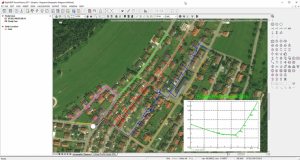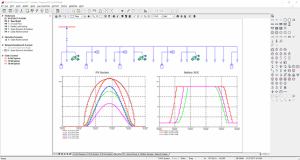Description
As every year, DIgSILENT released a new major version of PowerFactory. PowerFactory 2023 comes with a variety of new and enhanced features and equipment models. A few highlights we want to present in this video:
Power Transmission

The transmission grid is currently undergoing a major change to reliably accommodate increasing amounts of nondispatchable resources. PowerFactory offers a complete suite of functions for studying large interconnected power systems and addressing new challenges and emerging needs.
While maintaining operational efficiency and system-wide cost. The displacement of less flexible base-load generation by asynchronous wind and solar power generators imposes new challenges on the ability of the grid to maintain system stability.
PowerFactory offers a complete suite of functions for studying large interconnected power systems and addressing these emerging needs. Its fast and robust simulation algorithms can be applied to any AC or DC network topology and support the simulation of new technologies such as converter-based power generation, FACTS, voltage-sourced converters (VSC), HVDC cables and overhead lines, DC breakers, filters, and various types of MW- and Mvar-controllers and virtual power plants.
PowerFactory is also perfectly suited to transmission system operation planning. It integrates a comprehensive set of tools to support automatic and parallel grid safety analysis such as ENTSO-E D2CF/DACF/IDCF, and outage planning. Multiple interfaces (API, DGS, CIM) and flexible scripting languages (DPL, Python) enable smooth integration with existing systems.

Power Distribution

Different phasing technologies, such as single-wire earth return, twophase, bi-phase or classical three-phase systems, have created a need for multi-phase distribution power system modelling. PowerFactory provides comprehensive modelling features for studying all kinds of electrical networks.
PowerFactory provides comprehensive modelling features for studying all kinds of electrical networks with different phasing technologies, meshed or radial topologies and railway supply systems connected to public distribution systems.
In order to reduce network unbalance, improve quality of supply and optimise distribution networks, PowerFactory offers a large variety of functions, such as multi-phase load fl ow analysis, short-circuit analysis (IEC 60909, ANSI C37 and multiple fault analysis), harmonic analysis, quasi dynamic simulation, optimal power restoration and reliability assessment. Other standard features include the modelling of distributed generation and virtual power plants, voltage drop analysis, consideration of LV load diversity, daily load and generation profi les and easy-to-use protection coordination functionality.
Other important aspects
- Probabilistic analysis with stochastic modelling of distributed generation and load consumption
- Tie open point optimisation
- Optimal capacitor placement
- Voltage profile optimisation for bi-directional power flows
- Geographic diagrams (GPS-based) with background maps
- GIS and SCADA integration

Industrial Systems

To ensure continuity of production and the safety of personnel, the proper operation of industrial networks is of utmost importance. PowerFactory offers a vast array of functionality perfectly suited to the industrial user’s needs.
With high precision load fl ow algorithms, fl exible short-circuit calculation features, 4-wire modelling, protection system modelling, harmonic analysis and fi lter design options, PowerFactory offers a vast array of functionality perfectly suited to the industrial user’s needs. In addition, PowerFactory provides calculation accuracy, appropriate standards, clearly presented results, and a comprehensive and user-friendly interface.
Typically required studies include
- Analysis of voltage drop and transformer and generator regulation using load flow functionality
- Short-circuit calculations according to IEC, ANSI and VDE standards
- HV & LV cable sizing according to IEC, NF and BS standards; ampacity, voltage drop, short-circuit capability
- Motor starting, re-acceleration and voltage drop analysis
- Protection scheme coordination (overcurrent, differential, distance and signalling)
- Harmonic distortion and resonance studies; fi lter sizing
- Network reliability analysis, scenarios and fault models
- Time domain simulation for stability analysis and examination of electromagnetic transients









Reviews
There are no reviews yet.